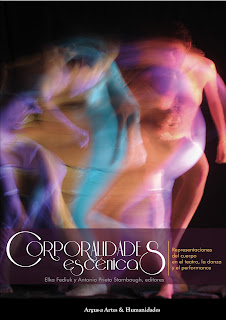 El cuerpo humano es el elemento central de las artes escénicas, aunque no siempre fue concebido como tal. El campo de las investigaciones escénicas se ha enriquecido en años recientes mediante aproximaciones a las perspectivas teóricas de la filosofía, la sociología, la antropología, la historia y los estudios de género y del performance para entender las múltiples y cambiantes maneras de realizar las corporalidades en escena, según las miradas que construyen o deconstruyen su sentido.
El cuerpo humano es el elemento central de las artes escénicas, aunque no siempre fue concebido como tal. El campo de las investigaciones escénicas se ha enriquecido en años recientes mediante aproximaciones a las perspectivas teóricas de la filosofía, la sociología, la antropología, la historia y los estudios de género y del performance para entender las múltiples y cambiantes maneras de realizar las corporalidades en escena, según las miradas que construyen o deconstruyen su sentido.
En el presente volumen 12 autores reflexionan acerca de las corporalidades escénicas en el teatro, la danza, el performance y los procesos pedagógicos en diversos ámbitos culturales y momentos históricos. La introducción ofrece un panorama dela práctica y la teorizacióndel cuerpo en las artes escénicas, en el que por‘corporalidad’ se entiende el conjunto de prácticas, imaginarios, representaciones y ejercicios de poder que involucran al cuerpo en sus dimensiones física, psíquica, emocional y sociocultural. Los capítulos que siguense agrupan en cuatro secciones; la primera,Cuerpo escénico e historia trata de las maneras en quese ha visto al cuerpo en distintas épocas a la luz de ideologías cambiantes, desde un estudio focalizado en la ciudad de Puebla, México,que expone los juicios y prejuicios en torno al cuerpo del actor en siglos pasados, hasta la conceptualización del cuerpo de la ballerinaa lo largo de casi doscientos años. La sección cierra con una reflexión centrada en el cuerpo como acontecimiento profundamente humano en la danza-teatro de Pina Bausch. La siguiente sección, Cuerpo y construcción poética, ofrece aproximaciones desde distintas poéticas, culturas y discursos artísticos, como son los trabajos sobre la inquietante corporalidad de los maniquíes escénicos de Tadeusz Kantor, las transformaciones ideológicas ligadas al cuerpo del actor en el teatro Kabuki y, finalmente, la reflexión sobre el cuerpo del clownen el teatro contemporáneo. En Cuerpo, transdisciplina y pedagogía se abordan fenómenos que expanden la noción de lo escénico desde la transdisciplina y la pedagogía performativa. La elaboración en torno al cuerpo multidimensional en el “transteatro” (en base al pensamiento de Basarab Nicolescu) es seguida de dos textos que se enfocan en la dimensión performativa y política del cuerpo en escenarios tanto académicos como sociales, desde la perspectiva de género. El libro cierra con la sección Cuerpo, violencia y memoria, con tres capítulos en los cuales se problematizan la escenificación de la violencia en el teatro mexicano contemporáneo, el cuerpo como “ejercicio de singularidad” en montajes actuales que se valen de las nuevas tecnologías, y la activación de la memoria colectivamediante relatos testimoniales en el teatro performativo de México y Brasil.
Sin duda el presente libro no agota la amplia temática del cuerpo en escena, pero es nuestro propósito contribuir a ese campo de estudio mediante las diversas perspectivas aquí plasmadas, y así generar nuevas preguntas para futuras investigaciones en torno a este cambiante fenómeno.
Staged corporalities
Representations of the body
in theater, dance and performance
Abstract
Today hardly anyone would deny that the human body is the central element of all performing arts, although this apparent fact has not always been taken as such.In an effort to understand the ever-changing way the body has been construed, imagined and staged, researchers of performing arts have recently been borrowing from the perspectives of philosophy, sociology, anthropology, history, as well as gender and performance studies, focusingon how the body is subjected to diverse ideological discourses and generates conflicting meanings.
The 12 authors of this volume reflect on the staged corporalities found in theater, dance, performance art and the university classroom in different cultural contexts and historical periods. The introduction provides an overview of the theory and practice of performing artsand their focus on ‘corporality’, i.e., the set of practices, images, representations and power exercises pertaining to the body in its physical, mental, emotional and socio-cultural dimensions.
The ensuing chapters are grouped into four sections. The first one, History of the Staged Body, deals with the understanding of the body at different times in the light of changing ideologies. It opens with a study on the prejudices actorsin Puebla, Mexico had to fight against during the past centuries, followed by a chapter on the ways the body of the ballerina has been conceptualized in the last two hundred years. The section closes with a discussion on the body as a deeply human event in the dance-theater of Pina Bausch. In the following section, Body and Poetic Construction, the body is approached by way of different poetic, cultural and artistic discourses. A piece on the disturbing corporality of Tadeusz Kantor’smannequins is followed by a discussion on the ideological transformations of the actor’s body in Kabuki theater, and a study on the body of the clown in contemporary theater. In Body, Trans-Discipline and Pedagogy, we encounter three chapters addressing the principles of trans-discipline, performative pedagogy and gender studies. The section opens with a study on the multi-dimensionality of the body in “transtheater” (based on Basarab Nicolescu’s theories), and continues with two texts about the performative and political dimension of the body in academic and social settings. Thechapters in the closing section, Body, Violence and Memory, address the staging of violence in contemporary Mexican theater, the“uniqueness” of the body in contemporary productions that avail of new technologies, and how testimonialnarrativeshelp to activatecollective memory in the performative theater of Mexico and Brazil.
The phenomenon of the body in performance opens up into a vast research field that can hardly be exhausted in one volume. Through their own views and questions, the authors of this volume hope to contribute to the field, and encourage further inquiry.


